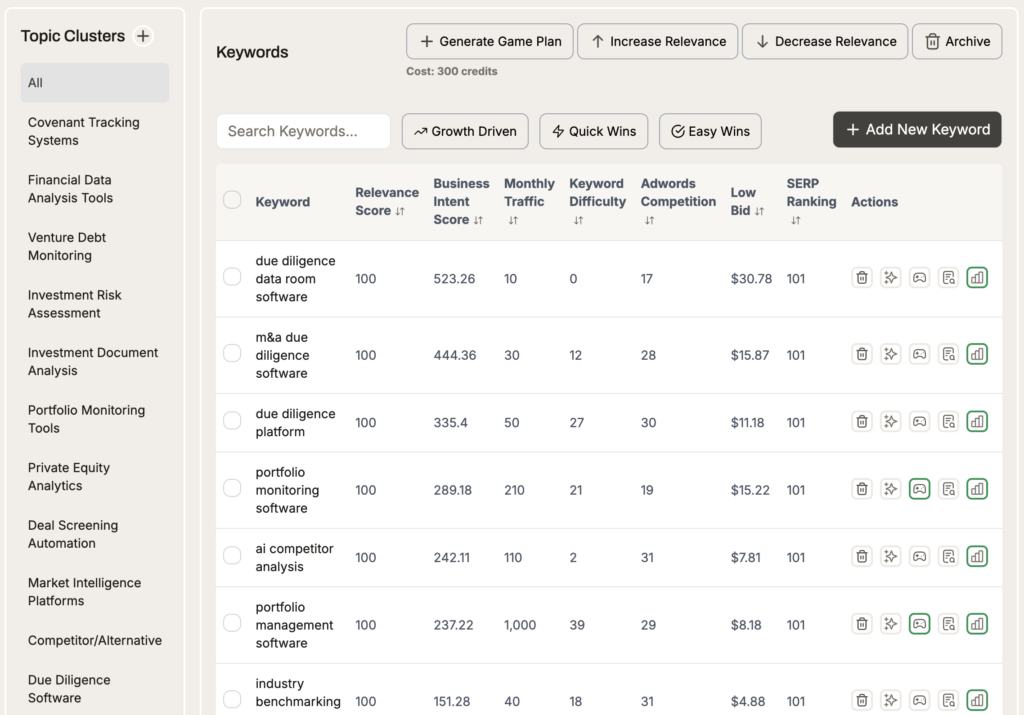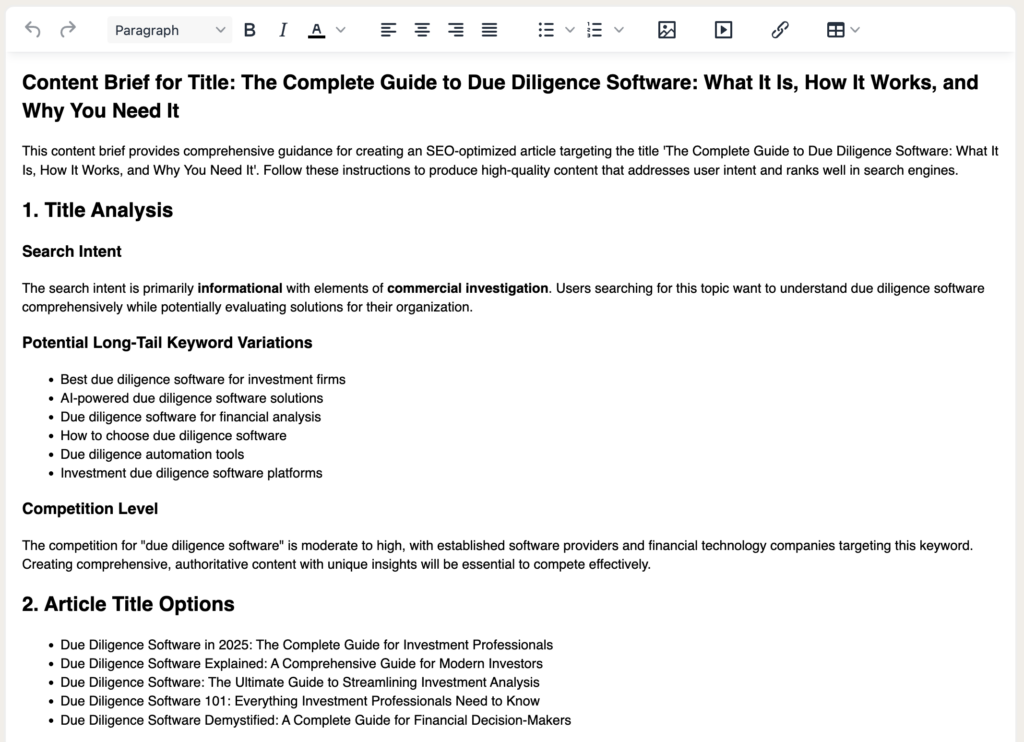Keywords are one of the most important factors for driving awareness, building an audience, and generating leads for your business.
Despite newer marketing channels in SaaS, blogs remain a powerful tool for delivering results because of their unique, long-term benefits that other channels can’t fully replace.
Studies show businesses that blog receive 55% more website visitors and generate 67% more leads than those that don’t. Source
This means without the right keywords, even the best-written blog post might not reach its intended audience.
And yet, many SaaS brands make the mistake of targeting broad, high-volume keywords that don’t align with their audience’s intent.
In this blog post, you’ll learn how to choose keywords that attract your ideal audience not just traffic. You’ll also get tips on search intent, long-tail strategy, and how tools like Enfra can make the process faster and easier.
Let’s get right into it.
Outline:
- Understand Your Target Audience
- Focus on Search Intent
- Leverage Topic Clusters
- Find and Analyse Keywords
- Organise and prioritise keywords
- Incorporate keywords naturally
- Measure and optimise
Understand Your Target Audience
If you don’t know who you’re writing for, even the most optimized keywords will fail to drive meaningful traffic or conversions.
In SaaS, your audience often consists of both decision-makers and end-users. Each group searches for solutions differently, which makes it important to personalize your content and keywords to meet their needs. And this is where a buyer persona comes in.
- Buyer Personas for SaaS
A buyer persona is a semi-fictional profile of your ideal customer created using market research, analytics, and real customer data.
Each group (decision makers and end-users) has unique pain points and uses different search terms when looking for solutions.
Creating buyer personas helps you plan for keywords they would use at different stages of the buyer’s journey (awareness, consideration, and decision).
- Ways to Research Audience Needs
1. Surveys and Interviews: Use tools like Google Forms or Typeform to gather structured feedback from your existing customers. Ask them detailed and specific questions about challenges they are facing regarding your product, and the features they value the most.
For deeper responses, conduct one-on-one interviews via Zoom or phone calls to understand the emotional triggers and motivations behind their needs.
Then, analyze the collected data to identify recurring angles and prioritize content ideas that address customer expectations.
2. Social Listening: Monitor conversations in LinkedIn groups, Reddit communities, and X (Twitter) to understand what your audience is talking about. Pay attention to repeated questions, complaints, and discussions to identify patterns, user frustrations, and industry-specific phrases.
You can use social listening tools like Hootsuite, and Sprout Social, to track when people talk about your brand, competitors, or specific keywords. However, knowing your audience’s tone and language helps you craft high-quality content that aligns with their emotions and communication style.
3. SaaS Review Platforms: Platforms like G2, and Capterra give explicit reviews about users’ experiences. Just by studying your users’ complaints, praised features, or unmet needs mentioned in reviews, you can spot content ideas and keyword opportunities that directly address your audience’s concerns and search intent.
Focus on Search Intent
It’d be easier to select the right keywords for your SaaS blog when you understand the reason behind a user’s query. Matching your content to what your audience actively searches for won’t only attract them, but also more likely to convert them.
There are four main types of search intent:
1. Informational Intent: These are users who are actively searching for knowledge or solutions. For example: “What is SaaS onboarding?, “How to integrate CRM tools”.
2. Navigational Intent: These are users whose main intent is specificity. For example: They are looking for a specific brand or product. For example, “Slack login”, “HubSpot pricing page”, etc.
3. Commercial Intent: These are common to users who are researching their options, but not ready to purchase yet. Example: “Top SaaS project management tools”, or “Best marketing automation software.
4. Transactional Intent: These are common to users who want to test your demo, sign up or purchase your product.
Examples are: “Buy project management SaaS tool”, or “Free trial for CRM software.”
Aligning your content with the right search intent makes sure that visitors get exactly what they are searching for.
Leverage Topic Clusters
Think about topic clusters like this: Your SaaS company just launched a customer onboarding software. You want your website to become the go-to resource for everything related to customer onboarding. But the topic is broad. If you want to write blogs without a clear strategy, your content will feel scattered and disconnected.
Now picture your pillar page as the “headquarters” of your content in a detailed guide titled “The Complete Guide to Customer Onboarding for SaaS Companies.” This page broadly explains the entire concept of onboarding: what it is, why it matters, strategies, and important success metrics.
Then, you create cluster blogs that go deep into each related topic, for example:
- 10 Customer Onboarding Metrics Every SaaS Company Should Track.
- How to Create a Winning Onboarding Email Sequence.
- The Role of Product Tours in Reducing Customer Churn
Now, each cluster blog links back to your pillar page, and your pillar page links to them. It’s like building a well-organized library where the main book (the pillar) references all the smaller, detailed books (the clusters), so both readers and search engines understand the full picture of your expertise.
Over time, your page authority will improve. This will also help your readers find all the information they need in one place.
Find and Analyze Keywords
Using a tool like Enfra can help you stop guessing and quickly uncover high-value keywords and your ranking potential. This enables you to focus on quick wins and easier opportunities before going after highly competitive keywords.
Here’s how:
- Enfra will help you with comprehensive keyword research to uncover untapped opportunities from scratch.
- Conduct In-depth competitor analysis to pinpoint exactly what works in your niche.
- Use Google SERP intelligence to identify ranking gaps and winning strategies specifically for your brand.

Once the research is done, Enfra’s AI transforms the data into ready-to-use content briefs or fully fleshed-out content pieces at scale.
You can check out how it’s done by booking a demo here.

You can also use other tools like SEMrush and Ahrefs to find low-competition, high-intent keywords that you can rank for and convert with.
Organize and Prioritize Keywords
Once you have gotten several keywords to rank for, you need to organize keywords by search intent and funnel stage.
If you want to focus on informational queries for awareness and visibility, target ToFu (Top of the Funnel) keywords.
For solution-aware queries, use MoFu (Middle of the Funnel) keywords.
To generate leads and drive conversions, BoFu (Bottom of the Funnel) keywords are your best option.
Use the tool keyword scoring to prioritize keywords that combine minimal difficulty with strong traffic and conversion potential. For SaaS, long-tail and feature-driven keywords often convert better because they target users with specific needs.
In your sheet, sort the keywords by difficulty from 0 to 100. Cluster them into related groups that can feed into a pillar page. This ensures your content strategy is organized, prevents keyword cannibalization, and strengthens your topical authority.
Finally, review your list regularly as search trends in SaaS evolve fast. You tend to update your strategy before competitors catch up.
Incorporate Keywords Naturally
The goal is to integrate keywords naturally into the content so it flows smoothly while still signaling relevance to search engines.
For example, use keywords in your title and introduction, and consider using synonyms instead of repeating the exact term. Enfra’s AI keyword suggestions help you find natural variations that improve topic coverage. For example, instead of forcing a phrase like “best SaaS project tool,” rewrite to “Choosing the best SaaS project tool depends on your team’s workflow.”
Finally, optimize meta descriptions, image alt texts, and internal links with keywords for SEO without overusing it.
With this approach, your content ranks well and engages readers, increasing time-on-page and conversions.
Measure and Optimize
It is ideal to measure continuously to either maintain rankings and drive conversions.
You can start by tracking key performance metrics like:
- Keyword rankings: Monitor how your target keywords are performing over time.
- Organic traffic: Check which posts attract the most qualified visitors.
- Click-through rate (CTR): A low CTR may indicate weak meta titles or descriptions.
- Conversions and sign-ups: Track which blog posts generate product trials, demos, or leads.
Entra can assist in automating keyword tracking and also generate content performance reports. However, it reveals which posts are losing visibility and recommend keywords or topics that could improve ranking.
However, refresh underperforming content. Update posts with new data, improved structure, or additional keywords that match current search intent. If a keyword isn’t driving traffic, Entra’s suggestions help you replace it with a higher-potential term.
Test and refine. Experiment with different keyword placements in headlines, meta tags, and internal links. Track results, iterate, and scale what works.
Choosing the right keywords isn’t just about getting traffic, it’s about reaching the right people with the right content. When you align your keywords with your audience’s intent, you increase your chances of turning readers into customers.. Don’t just guess, use data and strategy to guide your keyword choices.
